Continuing the parade of quotes from press reviews of Streamline Pictures releases. Today two more classic anime features: The Professional: Gogol 13 and Robot Carnival. To view this series of posts in its entirety click here.
“You may need an infusion of Disney after seeing “The Professional: Golgo 13,” just for balance. This new Japanese import is an amazing piece of animation, but it’s cold as ice in its violent storyline, making the cyberpunk “Akira” seem soft. But the hard-core, and hard-boiled, will want to check out this latest in a string of dynamic Japanimation features that have been drawing enthusiastic crowds.” “…the strength of the visual design and the skill of the animation are powerful hooks. And the dubbing of the English dialogue track, sometimes a drawback, is well done here, with the voices suited to their animated counterparts.”
Betsy Sherman, The Boston Globe, October 2, 1992, pg. ?
“Bloody, violent and heavy-on-the-sex japanimation. Yup, the animation you’ve seen out and about on CDs and elsewhere. This is it in its full-colored glory. The main color here is blood red as oceans of it gush out of people being stabbed, shot, raped or otherwise killed. […] Good anti-corporate-power attitude in this picture.”
Scott Munroe, Chairs Missing, April 1994, pg. [25]
“James Bond meets William Forsythe’s Day of the Jackal. Assassinations. Double-crosses. A killer who never misses.”
Peter A. Burke, Genesis, v.22 #1, August 1994, pg. 92
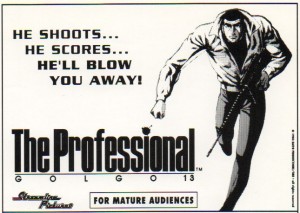
“This nihilistic Nippon assassin flick is an anime masterpiece, albeit a very downbeat one. Tweaking the conventions of the existential killer-for-hire genre, Dezaki’s film plays ingenious riffs on its material, taking surprising twists and turns at every point. The film’s eponymous loner anti-hero Golgo 13 (a.k.a. Duke Togo) is a super-cool killer who resembles Mr. Spock on steroids. When he sanctions the son of a ruthless oil magnate, the latter responds by using his financial clout to dispatch scads of government hit-squads and a trio of memorably monstrous killers on the Professional’s trail. Combining conventional cel-work with computer animation, the climactic showdown in the oil baron’s high-tech office fortress goes over like gangbusters — thanks to the baroque gore quotient and a finale that stands all pat action cliches on their heads.”
“The cel-work is dazzling, at times even poetic: a shore-side shooting with enough swooping gulls for a John Woo film; an extreme close-up of a bullet plowing into a victim’s brain, etc. The set-pieces, including a duel in an ascending elevator and Togo’s kiss-off of the billionaire are superb.” “In spite of the balletic, slo-mo lashings of blood, it’s hard to think of any film in the medium — or many live-action ones — that grapple (under the guise of escapism) with the utter waste underlying the spuma of slaughter. Like UNFORGIVEN and BULLET IN THE HEAD, this is a beautiful but unlovely film, and the final ironic, abrupt shot on a rainswept night street says it all.”
Todd French, Imagi-Movies, v.2 #4, Spring 1995, pg. 35
“…the ‘professional’ of the title is a hitman of supernatural stamina and resourcefulness, who goes by the name Golgo 13. (Wasn’t that the secret ingredient in Crest?) After bumping off the heir to the vast Dawson fortune, Golgo 13 becomes the target of a vendetta by supermogul Leonard Dawson, who bribes the entirety of the U.S. intelligence establishment — a surprising number of whose operatives have hooks — to help in his quest. Why he doesn’t just hire Golgo to kill himself is never explored. Some of the Americanization is unintentionally comic: Golgo heads to Sicily, where he meets a sexy Mafia boss named Cindy. (I hear ‘Cindy’ is a very popular name among dons these days.)” “The visual style is a nice translation of noir and action film conventions, but the exercise seems pointless. Action scenes that would be thrilling with live actors lose their sense of spectacle: who cares about a San Francisco car chase (The Professional has one) when it’s animated?”
Andy Klein, Los Angeles Reader, v.15 #17, February 5, 1993, pg. 20

“…”The Professional,” a new Japanese animated feature (…) repeats all the fast-paced cliches of the genre. There are car crashes, motorcycle wrecks, machine gun battles, helicopter attacks, stabbings, fistfights, martial arts duels, explosions and gallons of blood-red paint.” “Director Osamu Dezaki uses rapid cutting, split-screen imagery, computer graphics and slow pans.” “A social psychologist could probably write a Ph.D. thesis on the meaning of a story in which a lone Japanese assassin triumphs over the combined resources of the FBI, the CIA, the Pentagon, the Mafia and the most powerful oil billionaire in the Western World.”
Charles Solomon, Los Angeles Times, February 5, 1993, pg. F-6
“Graphic Professional is Fine Adult Fare” “It is no surprise that on the cutting edge of the world’s animation boom are the Japanese; just as they have with cars and electronics, the Easterners have taken an American product and are improving it.” “Since animated films are more taxing on the viewer’s eye and patience than their live-action counterparts — the concentration needed to take in the explosion of color and sound is considerable — director Osamu Dezaki is wise to keep the running time to 95 minutes. The animation is frenetic and artsy, the work of over 50 animators. For fans of John Woo films — splashy, action-packed shootouts such as The Killer and Hard-Boiled — The Professional may seem tame, but will probably be nonetheless appealing. Those weaned on wisecracking bunnies and sarcastic ducks will either be horrified, mesmerized, or scarred indefinitely.”
Alex Demyanenko, L.A. Village View, v.7 #27, February 5-11, 1993, pg. 12-14
“What’s interesting about this movie has nothing to do with its substance, or even its story. It’s the animation, directed by Osamu Dezaki, that has a diverting and graphic power.”
F. X. Feeney, L.A. Weekly, v.16 #7, January 14-20, 1994, pg. 48
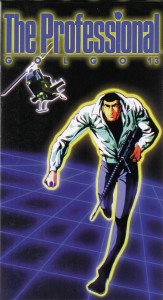
“For a long time people have accused the James Bond movies of being cartoons. Now they are. Sure, there are some important differences. [Golgo 13] doesn’t work for the British Secret Service; he’s on his own. He has his own version of Bond’s M and Q, who brief him on assignments, drop off their gadgets but then turn up dead. The 007 similarities are obvious. Like Bond, Duke Togo is a ruthless, seemingly invincible killer. Scads of women — women, naturally, with extremely large breasts — fall into his arms and his bed at the wink of an eye. And around every corner is an even more ruthless, seemingly even more invincible killer waiting for Togo with a private army. It’s “Goldfinger” taken seriously, “Diamonds Are Forever” done straight, with all of the melodramatics of Bond but none of the occasional humor or self-parody.” “Whoever did the direction did a good job (although there are way too many shots of things upside down or reflected in pools). The animation is, like a lot of animation done in the big Asian cartoon factories, soulless but slick. And the story moves like a bullet.” “But the movie is a sexy, creepy, well-done adventure. And until the next Bond film comes along, it’ll do just fine.”
Stephen Whitty, San Jose, CA Mercury News, November 13, 1992, pg. ?
“‘The Professional’ hurts. Animated cartoons aren’t supposed to hurt. But after watching the many ornate ways a body can be bashed, slashed, gouged, riddled, you can be forgiven for checking your rib cage for ruptures. Which, in a way, is a tribute to the blunt power generated by this feature starring Japanese comic book artist Takao Saito’s most popular and disturbing creation, Duke Togo, aka Golgo 13, a professional killer with an inscrutable — and unfathomable — code of ethics.” “‘The Professional,’ true to the tradition of hard-core Japanese animation, gets more baroque with its bloodbaths than any action director could.” “Despite some moments of conceptual daring, “The Professional” is the sort of thing your brain would come up with if it were undergoing delirium treatments from overexposure to live-action body-count epics like the “Die Hard” series.”
Gene Seymour, New York Newsday, November 23, 1992, pg. ?
“What strikes me as really different about “The Professional” is the way its hero owes allegiance to no one. Of course he’s a loner, as almost all action heroes are. But it’s generally part of a superhero’s resume that he be an ex- or rogue cop or government agent. He may not be part of the establishment, but he is still, in some way, connected to it. Takao Saito, the Japanese creator of the Golgo 13 comic book series, has fine-tuned the Western superhero to the point where he’s so much the loner it’s creepy. Not even the Terminator is this inhuman.”
Matthew Flamm, New York Post, October 23, 1992, pg. 28
“…the James Bond-like story (…), the (particularly) beautiful animation, and the excellent dubbing make THE PROFESSIONAL a good buy.”
unsigned, Protoculture Addicts, #25, December 1993, pg. 36
“… most shockingly graphic…” “As a live-action movie, this would definitely earn an R rating with its nihilistic vision of a world of sin and corruption.”
John Stanley, San Francisco Chronicle, January 20, 1993, pg. ?
“… the surreal homicidal [killers] all fight to the death with Golgo 13 in a computer-animated highrise that is nothing less than thrilling animation all the way. Fun stuff — but violent as hell, with the usual anime slo-mo blood splashes, and with some stark sexual couplings …
Robert DuPree, Subliminal Tattoos, #2, [August] 1994, pg. 64
“Adapted from the classic comic book series created by Takao Saito, THE PROFESSIONAL is one of the most thrilling animated films ever made. This fast-paced and highly stylized feature breaks new ground in both technique (a computer animated finale set in and around a San Francisco high-rise) and adult content (a virtual cornucopia of sex and violence). What is truly remarkable about THE PROFESSIONAL is its ability to transcend the medium of animation, allowing viewers to forget they are watching a cartoon. The script is filled with plot twists and outrageous characters that keep Golgo 13 in a constant state of danger. The film’s finale is both cathartic and surreal at the same time; an achievement usually reserved for the best live action films.”
Michael Swanigan, Toon Magazine, #6, Winter 1995, pg. 5
“If Bruce Willis actioners like Die Hard and The Last Boy Scout had gone the animation route, they’d probably look a lot like The Professional.”
unsigned, The Phantom of the Movies’ VideoScope, v.2 no. 9, May 15-July 15, 1994, pg. 16
“A futuristic Fantasia! Japan’s answer to Heavy Metal! These were some of the reactions to Robot Carnival, the anthology feature coordinated by A.P.P.P. Ltd. (Another Push Pin Production Ltd.) in 1987. Although it had a theatrical release, Robot Carnival was primarily intended for the Japanese home video market, where it became one of the top 10 animation sellers in 1987, despite its end-of-the-year release.” “…basically Robot Carnival consists of eight musical mood pieces ranging from lively rock to poetic ballad. The opening and closing sequences […] tell a hilariously black comedy about what happens the day that the Robot Carnival comes to town. […] ‘Frankenstein’s Gears,’ directed by Koji Morimoto, shows the final, despairing efforts of an elderly mad scientist to bring his robot creation to life — and why he should have taken up some other hobby instead. ‘Deprive’ (Hidetoshi Ohmori) is a fast-paced rock battle between a humanized robot and a handsome but cruel punk alien invader for possession of The Girl. ‘Presence’ (Yasuomi Umetsu) is a tragic romance in a future back-to-nature society in which robots are illegal. A young scientist, defying restrictions on research, builds a beautiful robot girl. However, she is programmed to love him too strongly [leaving him] no choice but to dismantle her — but she haunts him for the rest of his life. ‘Starlight Angel’ (Hiroyuki Kitazume) takes place in an amusement park of the future (which we will all recognize) with robot attendants. A teenager has a romantic disappointment and finds one of the robots to be more sympathetic than her boyfriend.
‘Clouds’ (Mao Lambdo) is a dreamy mood piece about a robot child who marvels at the wonders of nature. [‘A Tale of Two Robots’] (Hiroyuki Kitakubo) is a hilarious parody of Japanese World War II propaganda cartoons. 19th-century Japan is invaded by a Western Imperialist devil in the person of an American Civil War-era giant robot. He is heroically opposed by a Japanese boys’ club with its giant steam-powered samurai warrior robot. Alas, both sides have a hard time getting their acts together. [‘Nightmare’] (Takashi Nakamura) personifies fears that modern society has become overly mechanized and soulless. A drunk awakens late at night in a Tokyo alley and is horrified to see what goes on when all the humans are at home and asleep. This segment is a bit too obviously derivative of Metropolis, the ‘Night on Bald Mountain’ sequence in Fantasia and the Headless Horseman chase sequence in Ichabod and Mr. Toad, but is still enjoyable for its fast-paced and humorous action and its catchy music. Ichabod Crane on a Honda scooter!?”
Walt James, Animation Magazine, v.2 #3, Winter 1989, pg. 71
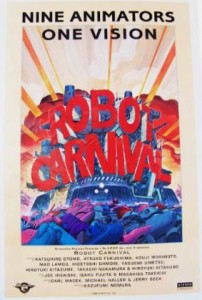
“Enter Robot Carnival, a mid-1980s Japanese techno-Fantasia with a twist.” “Unlike Fantasia, Robot Carnival’s segments are produced by different teams, each with their own distinct style, while all the music is composed by Jo Hisaishi.” “In some ways, Robot Carnival’s structure is much like that of Fantasia. It gambols through some light-hearted sequences, takes time out for a relatively somber short, has a trio of shorts (one light-hearted, one “art,” and one uproariously funny), and a final, dark sequence.”
Emru Townsend, Animato, #21, Spring 1991, pg. 54-55
“Robot Carnival is a collection of Japanese animated shorts that should be required viewing for anyone who thinks Japanese anime is all giant robots, shower scenes and half-clad bimbos in power armor. The animation in these shorts ranges from the excellent to the fantastic while the stories range from the ho-hum to the down right good. The genres are mixed. My personal favorite of the shorts is ‘Presence,’ a poignant story of an inventor who creates a lovely female android only to discover that she has a mind of her own. Beautiful animation combined with an excellent story.” “As I’m a Fantasia fan, another favorite from this collection is ‘Nightmare.’ If you like the ‘Night on Bald Mountain’ sequence of Fantasia as I do, you definitely will enjoy this one. ‘Franken’s Gear’ is another favorite. It’s a variation of the Frankenstein theme, only this time the life created by a truly mad scientist is made of gears and servos. Another fantastic piece of animation.” “Except for ‘Presence,’ which is heavily dependent on dialogue for its story, Robot Carnival is more a treat for the eyes than for the ears. Where there is dialogue, however, Streamline has done a very good job of dubbing it.”
Randall Stukey, Anime Dispatches, v.2 #1, January-February 1992, pg. 22
“I discovered Robot Carnival at a convention, sat in rapt attention, and subsequently was forced by some all-controlling voice in my head to procure the Bandai laser disc. I will watch this collection of nine very different anime stories over and over. Because. The exact reasons aren’t difficult to enumerate. In most respects, the visions of the nine directors involved are unique, imaginative reveries, executed with a level of fluidity and visual impact rarely seen in the field.” “Both veteran collectors and newcomers alike will find Robot Carnival a good variety of styles and stories in one package.”
Rick Sternbach, Animerica, v.1 #8, October 1993, pg. 61
“Robot Carnival is a wall-to-wall eyeball feast, starting with opening credits. It’s a finely controlled sequence of comedy, grace, and mayhem as the words ROBOT CARNIVAL, themselves a city-sized robot, smash their way through the town they’re supposed to entertain. Other highlights include a sequence titled ‘Cloud,’ which shows a robot’s life-journey in painterly pastoral and apocalyptic images. ‘Presence’ is the strange and melancholy story of a man who never quite grows up, and decides to create the perfect female robot. The animators use images of time and the robot-builder’s imagination to exquisite effect. ‘A Tale of Two Robots’ is the imaginative and satirical tale of a battle between two huge steam-driven Transformer-style robots in the 19th century. ‘Nightmare’ is a wild, post-apocalyptic ‘Sorcerer’s Apprentice’ […]. Robot Carnival is a terrific sampler of Japanese animation styles, from realistic to stylized, from funny to somber.”
Richard Kadrey, Covert Culture Sourcebook 2.0 (St. Martin’s Press, 1994), pg. 155
“Nine of Japan’s best animators took part in this compilation of robot-based mini-features. […] Each one has its own story to tell, and some are more distinct than others, but by the end they tend to all blend together. There are two notable exceptions, and they happen to be the only two with dialogue (in English). ‘A Tale of Two Robots’ is the only animated short to provide us with laughter. In it, the self-dubbed ‘world’s greatest genius’ is intent on destroying this 19th century Japanese city.” “It’s not so much that the animation is superior to the other films, or even differs from them, but rather that this one has an interesting story to tell, and does so in amusing fashion. The facial expressions on these animated characters are impressively real, and their dialogue is witty. The best, most fully realized animated short, however, is ‘Presence.'” “Designed, written and directed by Yasuomi Umetsu, ‘Presence’ boasts meticulously crafted animation, and a moving narrative. The details in each frame are well thought out. You can see the folds in his shirt change subtly with each movement. The writing is almost as impressive as the drawing.” “These two shorts alone are worth the price of admission. Not that any of the others are awful, it’s just that they pale in comparison. They all have moments of brilliance, but only ‘A Tale of Two Robots’ and ‘Presence’ are consistent. The ‘Opening/Closing’ segments of the film are commendable. They set the tone and finish with an irreverent bang.” “In ‘Robot Carnival’ some rides are better than others, and they’re the ones that stay with you. All things considered, it’s worth the trip.”
Jeff Menell, The Hollywood Reporter, March 19, 1991, pgs. 10 & 49
“Like many anthology-format features, this is a mixed bag. Adopting a ‘Man against (or in love with) Machine’ theme, the film is filled with genial but inconsequential mech-mate soap opera fluff (‘Starlight Angel,’ ‘Deprive’) and, content-wise, is too wispy and diffuse to really sustain extended interest. However, the feature does contain two superb episodes: the wraparound segs by AKIRA creator Katsuhiro Otomo, which have the Robot Carnival descending on a futuristic desert burg; and Yasuomi Umetsu’s enchanting and totally moving ‘Presence.’ The latter tale, about an inventor’s initial inability to cope with the very human feelings with which he has – unwittingly – endowed his beautiful android, is an affecting meditation on unrequited love and responsibility. The Umetsu episode also scores some gentle and knowing satiric jabs at Nippon anime for its penchant for relegating its cyborg femmes to the role of pliable sex-toys (‘I’m not a pet,’ the inventor’s creation protests). With its understated mood and atmosphere, ‘Presence’ scores well above the rest of ROBOT CARNIVAL’s metal sturm-und-drang. Kudos should also go to Hiroyuki Kitakubo’s ‘A Tale of Two Robots,’ which amusingly transplants all the cliches of the mecha genre to an 18th-century Japanese setting.”
Todd French, Imagi-Movies, v.2 #4, Summer 1995, pg. 35
“Three decades ago, the Japanese cinema created Godzilla as a metaphor for anxiety toward the atom bomb. In Robot Carnival […] Japanese social anxieties appear to have shifted to the figure of the robot: all but one of these technically sophisticated shorts pit humanity against unbalanced appliances that seem to be coming at Japanese culture from every corner. Humanity, as defined by these shorts, is the kind found on the sides of Hello Kitty lunch boxes — wide-eyed and innocent, sentimental and empty-headed — leaving the viewer to choose between totalitarian technology or a world of heroic people drawn with button noses.”
Dave Gardetta, L.A. Weekly, May 10, 1991, pg. ?
“A potpourri of shorts, which is always the best showcase for animators: if you don’t like one, there’s always another on the way. What’s particularly pleasurable about these shorts is that they are, with two exceptions, entirely nonverbal, thus creating worlds and moods entirely beyond the reach of any other art form.” “The nice thing about the ‘plots’ of these shorts is that, despite (or perhaps thanks to) their familiarity, they serve the ends of animation beautifully, like themes in a jazz musician’s improvisation.”
F. X. Feeney, L.A. Weekly, v.16 #11, February 11-17, 1994, pg. 56
“A Japanese anthology on robot themes, with several very funny segments and a variety of styles.”
Andy Klein, Los Angeles Reader, v.16 #18, Feb. 11, 1994, pg. 42
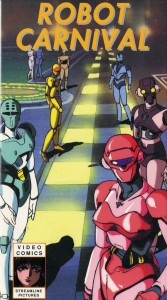
“‘Robot Carnival’ […] is a feature-length collection of eight unrelated short films that highlight the strengths – and weaknesses – of contemporary Japanese animation. The most interesting segments showcase the Japanese flair for creating wonderfully imaginative robots that look both mechanical and biomorphic. (This design skill has had a profound impact on the toy industry. The popular, metamorphic robot toys of the last decade, including Transformers and Go-Bots, were based on Japanese models.) In ‘Opening/Closing’ by Atsuko Fukushima and Katsuhiro Otomo, a city-sized complex of ma-chines threatens to destroy a desert-like planet, only to transform itself into a dazzlingly kitsch mechanical carnival, replete with dancing dolls and clockwork musicians. Two young lovers in a futuristic amusement park are menaced by a towering robot-demon – a fantastic construction of steel bones, talons and spikes – in ‘Starlight Angel’ by Hiroyuki Kitazume. Imaginative camera work and cutting adds to the sense of wonder the robots generate.” “… it will undoubtedly appeal to designers, to the growing legion of Japanese cartoon fans, and to children who play with robot toys.”
Charles Solomon, Los Angeles Times, May 15, 1991, pg. F3
“Among the U.S. premieres scheduled is ‘Robot Carnival,’ a heavy-metal compilation of shorts involving robots, made by nine of Japan’s leading animators. These shorts range from roboticized teen romances to apocalyptic showdowns between humans and machinery. From the surrealistic nightmare of ‘Nightmare,’ to the hopelessly old-fashioned world of the future of ‘Presence’ (where men still can’t handle having successful wives), these shorts show off the style, fluidity and imagination of Japanimators.”
Jami Bernard, New York Post, March 13, 1991, pg. ?
“Streamline Pictures didn’t do a lot of dubbing in this movie but whatever was needed was well done. A must for someone who really wants to explore Japanese animation and see some unusual stuff.”
Martin Ouellette, Protoculture Addicts, #18, July-August 1992, pg. 25
“This omnibus feature may be the best anime introduction for the novice. Its seven vignettes run the gamut from harrowing to hilarious.”
Glenn Kenny, Pulse!, #107, August 1992, pg. 84
“The omnibus film Robot Carnival is the most representative introduction to Japanese animation anyone could ask for. A diverse palette of anime styles and sub-genres are showcased in 8 vignettes, each of which presents an entirely different take on robotics, with nods toward the myth of the technological eclipse of man, the inanity of giant-robot battles, the irony of robots who can love more deeply that we and the ennui engendered by the counterpoint between cybernetics and organic naturalism.”
Steven Feldman, The Rose, v.5 #29, September 1991, pgs. 8-9
“‘Robot Carnival’ is a Japanese animation film, an anthology of eight shorts, all of which deal in some way with robots. It’s a must-see for all those Japanese animated robot fans. For everyone else it’s a hit-and-miss affair — mostly miss, but the hits are memorable.” “Only two films in ‘Robot Carnival’ seem inspired, and both of them are lovely. Mao Lamdo’s ‘Cloud,’ about a little boy robot’s discovery of nature, is done in delicate black-and-white line drawings, with a new-age music background. The boy walks along as clouds go by and transform into various shapes. The other highlight is Yasuomi Umetsu’s ‘Presence,’ a tragic story about a lonely man who creates a beautiful android and then destroys her when he discovers she is capable of independent thinking.”
Mick LaSalle, San Francisco Chronicle, March 16, 1991, pg. ?
“Eye-popping hi-tech animation is the order of the day.” […] “The uniformly fine artwork all through Robot Carnival is something to see.”
Lisa Jensen, Santa Cruz Good Times, April 11, 1991, pg. 32
“… a tasty robot-themed anthology that showcases some of Japan’s most innovative anime creators …”
Glenn Kenny, TV Guide, v.42 #53, #2179, Dec. 31, 1994 – Jan. 6, 1995, pg. 35
“A collection of eight short fantasy films, ‘Robot Carnival’ showcases the skills of some of Japan’s top animators. Technically, all the work is firstrate, but, in a few of the films, conventional plots and characters undo the high standards of the animation.” “Kouji Morimoto’s dazzling ‘Franken’s Gears,’ one of the best entries, retells ‘Frankenstein’ with dramatic flashes of lightning. When the robot/monster comes to life, tubes shatter and the creator is left awestruck. Animation buffs will be impressed, too. In ‘Presence,’ a longer study of an inventor who falls in love with his robot, Yasuomi Umetsu applies a more lyrical touch. The animation is so detailed that the backgrounds and shadows seem startlingly real. Unfortunately, the stilted English dialog and perfect-looking characters are less convincing.” “More inventive is Takashi Nakamura’s ‘Nightmare,’ with its Ralph Steadman-inspired swarm of robots overrunning a city. ‘Cloud,’ which has the least to do with robots, has a dreamy feel to it as Mao Lamdo transforms clouds into fleeting images. Even the opening and closing credits of ‘Robot Carnival’ are beautifully animated (by Atsuko Fukushima and Katsuhiro Otomo, who directed ‘Akira’). Pic’s title is a huge machine destroying everything in its path.”
“Stev.”, Variety, March 18, 1991, pg. ?
“Anime buffs should find Robot Carnival a super sampler of current state-of-the-art animation styles.”
unsigned, The Phantom of the Movies’ VideoScope, v.1 #1, January-February 1993, pg. 10
“Folks for whom Blade Runner, Neuromancer, and Game Boy aren’t sci-fi but square one are understandably enthralled with Japanese animation. Despite lingering anxieties about massive annihilation, the Japanese taste for gadgetry sand the clean line of industrial design makes their cartoons the least Luddite art form on earth.” “Ranging from imaginative euphoria to marshmallow schlock, Robot Carnival falls a bit short of the consistency or bite of its American predecessor, Heavy Metal, but the better shorts challenge and explore the boundaries of machines and the texture of technology.” “In the hands of Japanese animators, toys and dolls are no less robot larvae than cars and motorbikes.”
Erik Davis, (New York) Village Voice, March 19, 1991, pg. 60
“Robot Carnival offers a terrific collection of eight animated shorts…” “What you get on this tape is a feast of pure visual storytelling.” “Although beautifully drawn, the softer selections, such as Hiroyuki Kitazume’s “Starlight Angel” and Mao Lamdo’s “Clouds” did not impress me as much as the harder-edged “Franken’s Gear” by Kouji Morimoto and “A Tale of Two Robots” by Hiroyuki Kitakubo. I give two circuits up for this brilliant android anthology.”
Kyle McCulloch, Wild Cartoon Kingdom, #3, March 1994, pg. 73
Next week: They really do go on forever


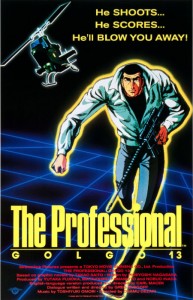
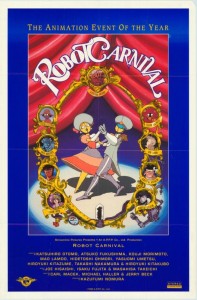
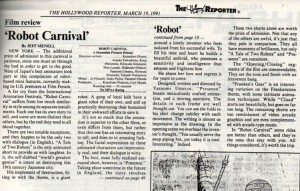

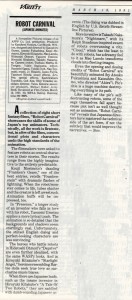
 Fred Patten (1940-2018) was an internationally respected comics and animation historian. He has written about anime or comic books for publications ranging from Animation Magazine and Alter Ego to Starlog. He was a contributor to The Animated Movie Guide (2005), and is author of Watching Anime, Reading Manga (2004, Stone Bridge Press), a collection of his best essays, and Funny Animals and More (2014, Theme Park Press), based upon his early columns here on Cartoon Research. He passed away on November 12th, 2018.
Fred Patten (1940-2018) was an internationally respected comics and animation historian. He has written about anime or comic books for publications ranging from Animation Magazine and Alter Ego to Starlog. He was a contributor to The Animated Movie Guide (2005), and is author of Watching Anime, Reading Manga (2004, Stone Bridge Press), a collection of his best essays, and Funny Animals and More (2014, Theme Park Press), based upon his early columns here on Cartoon Research. He passed away on November 12th, 2018.





































I got the impression that Andy Klein of the “Los Angeles Reader” didn’t believe that we were using the original Japanese character names in “The Professional”. But a Mafia boss named Cindy — yeah, I understand that Takao Saito hated the movie because of TMS’ script, too. U.S. government killers? Saito always tried to make his “Golgo 13” scenarios plausible, even when he was inventing a hidden Nazi 4th Reich in Argentina, rather than a burlesque of corruption and violence.
Reminded myself I enjoyed “Cloud” most of all in that. It was something ‘different’ for such a compilation. Mao Lamdo is still out there (found him on Twitter).
One of the nicest things about “Robot Carnival” was that the eight sequences were all so different that practically everyone had a different favorite and a different least favorite, but everyone respected all of them as being of high quality. And the music was so different also, each’s music fitting it so well; but all the music was by Jo Hisashi.
I still, after 25 years, can’t decide which I like the best — probably the opening/closing sequence by Atsuko Fukushima & Katsuhiro Otomo, and with the Robot Carnival’s march.
That was a crowning moment of the whole thing. It leads us in and then exists us out.
Love to see what kind of features Discotek may bring for the DVD release, as I’m sure this is worthy of a commentary track at least. Reminded I have some cels from the different segments in my collection too. I got some of the boy who alerts the village of the “ROBOT CARNIVAL” approaching.